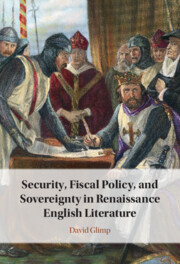Refine search
Actions for selected content:
417 results
Chapter 2 - Public and Private Interests
-
- Book:
- The State, the Law, and the People in the Roman Empire
- Published online:
- 11 December 2025
- Print publication:
- 11 December 2025, pp 64-118
-
- Chapter
- Export citation
Older Adults and Tax Delegation in Canada: A Sociotechnical Analysis
-
- Journal:
- Canadian Journal on Aging / La Revue canadienne du vieillissement , First View
- Published online by Cambridge University Press:
- 10 December 2025, pp. 1-14
-
- Article
-
- You have access
- Open access
- HTML
- Export citation
The Structure of Liberty in Montesquieu and Adam Smith
-
- Journal:
- Social Philosophy and Policy / Volume 42 / Issue 2 / Winter 2025
- Published online by Cambridge University Press:
- 16 December 2025, pp. 368-386
- Print publication:
- Winter 2025
-
- Article
- Export citation
An Emendation of Adam Smith’s “Luxury Hypothesis”
-
- Journal:
- Social Philosophy and Policy / Volume 42 / Issue 2 / Winter 2025
- Published online by Cambridge University Press:
- 16 December 2025, pp. 402-415
- Print publication:
- Winter 2025
-
- Article
-
- You have access
- Open access
- HTML
- Export citation
15 - Mandates, Trusteeship, and Decolonization in the North Pacific: Balancing Self-Determination, Development, and Security
- from Part IV - The High Cold War in Asia
-
-
- Book:
- East Asia and the Modern International Order
- Published online:
- 25 November 2025
- Print publication:
- 20 November 2025, pp 278-296
-
- Chapter
- Export citation
5 - The Military State
-
- Book:
- States of Transition
- Published online:
- 31 October 2025
- Print publication:
- 13 November 2025, pp 110-127
-
- Chapter
- Export citation
2 - Democracy Must Be Defended
- from Part I - Contextualizations
-
- Book:
- Moral Autopsy
- Published online:
- 18 November 2025
- Print publication:
- 30 October 2025, pp 93-132
-
- Chapter
- Export citation
State gender and ontological dislocation: Gendering Iran’s revolutionary identity and nuclear behaviour
-
- Journal:
- Review of International Studies , First View
- Published online by Cambridge University Press:
- 30 October 2025, pp. 1-19
-
- Article
-
- You have access
- Open access
- HTML
- Export citation
Fractured Extraction: Mining Firms, Provinces and Municipalities in the Decentralized Politics of China’s Rare Earth Production
-
- Journal:
- The China Quarterly , First View
- Published online by Cambridge University Press:
- 29 October 2025, pp. 1-22
-
- Article
-
- You have access
- Open access
- HTML
- Export citation
9 - Being a Public Woman: Streets, Cars, Crimes, and the Shifting Calculus of Moral Accountability
-
- Book:
- Tied Up in Tehran
- Published online:
- 28 September 2025
- Print publication:
- 16 October 2025, pp 228-256
-
- Chapter
- Export citation
1 - Protecting Bad Intel in a Dirty War
- from Part I - Struggle to Conceal
-
- Book:
- Curating the Colonial Past
- Published online:
- 12 September 2025
- Print publication:
- 02 October 2025, pp 35-57
-
- Chapter
- Export citation
Chapter 8 - Mandates and the Design of Peace Agreements
-
- Book:
- The Peacemaking Mandate
- Published online:
- 12 September 2025
- Print publication:
- 02 October 2025, pp 183-220
-
- Chapter
- Export citation
A hybrid classification approach for exploring Iraq’s welfare regime
-
- Journal:
- Journal of International and Comparative Social Policy / Volume 41 / Issue 2 / July 2025
- Published online by Cambridge University Press:
- 24 September 2025, pp. 160-180
-
- Article
-
- You have access
- Open access
- HTML
- Export citation
Chapter 2 - Funding Utopia
-
- Book:
- Security, Fiscal Policy, and Sovereignty in Renaissance English Literature
- Published online:
- 04 September 2025
- Print publication:
- 18 September 2025, pp 32-57
-
- Chapter
- Export citation
Chapter 6 - Metasecurity Dilemmas in John Milton’s Late Poems
-
- Book:
- Security, Fiscal Policy, and Sovereignty in Renaissance English Literature
- Published online:
- 04 September 2025
- Print publication:
- 18 September 2025, pp 161-202
-
- Chapter
- Export citation
Chapter 5 - George Herbert’s Fiscal Theology
-
- Book:
- Security, Fiscal Policy, and Sovereignty in Renaissance English Literature
- Published online:
- 04 September 2025
- Print publication:
- 18 September 2025, pp 127-160
-
- Chapter
- Export citation
Human Rights Protection in Europe and Russia: Addressing the Implications of Russian Expulsion Under the Statute of the Council of Europe and the European Convention on Human Rights
-
- Journal:
- International Journal of Legal Information / Volume 53 / Issue 3 / Winter 2025
- Published online by Cambridge University Press:
- 16 September 2025, pp. 187-198
- Print publication:
- Winter 2025
-
- Article
- Export citation

Security, Fiscal Policy, and Sovereignty in Renaissance English Literature
-
- Published online:
- 04 September 2025
- Print publication:
- 18 September 2025
4 - Gifts that Keep on Giving: Kashmir, Article 370, and Pakistan
-
- Book:
- Weaponizing Language
- Published online:
- 27 November 2025
- Print publication:
- 28 August 2025, pp 120-147
-
- Chapter
- Export citation
4 - New Technologies and Enforced Disappearances
-
-
- Book:
- Enforced Disappearances
- Published online:
- 07 August 2025
- Print publication:
- 21 August 2025, pp 78-102
-
- Chapter
-
- You have access
- Open access
- HTML
- Export citation
